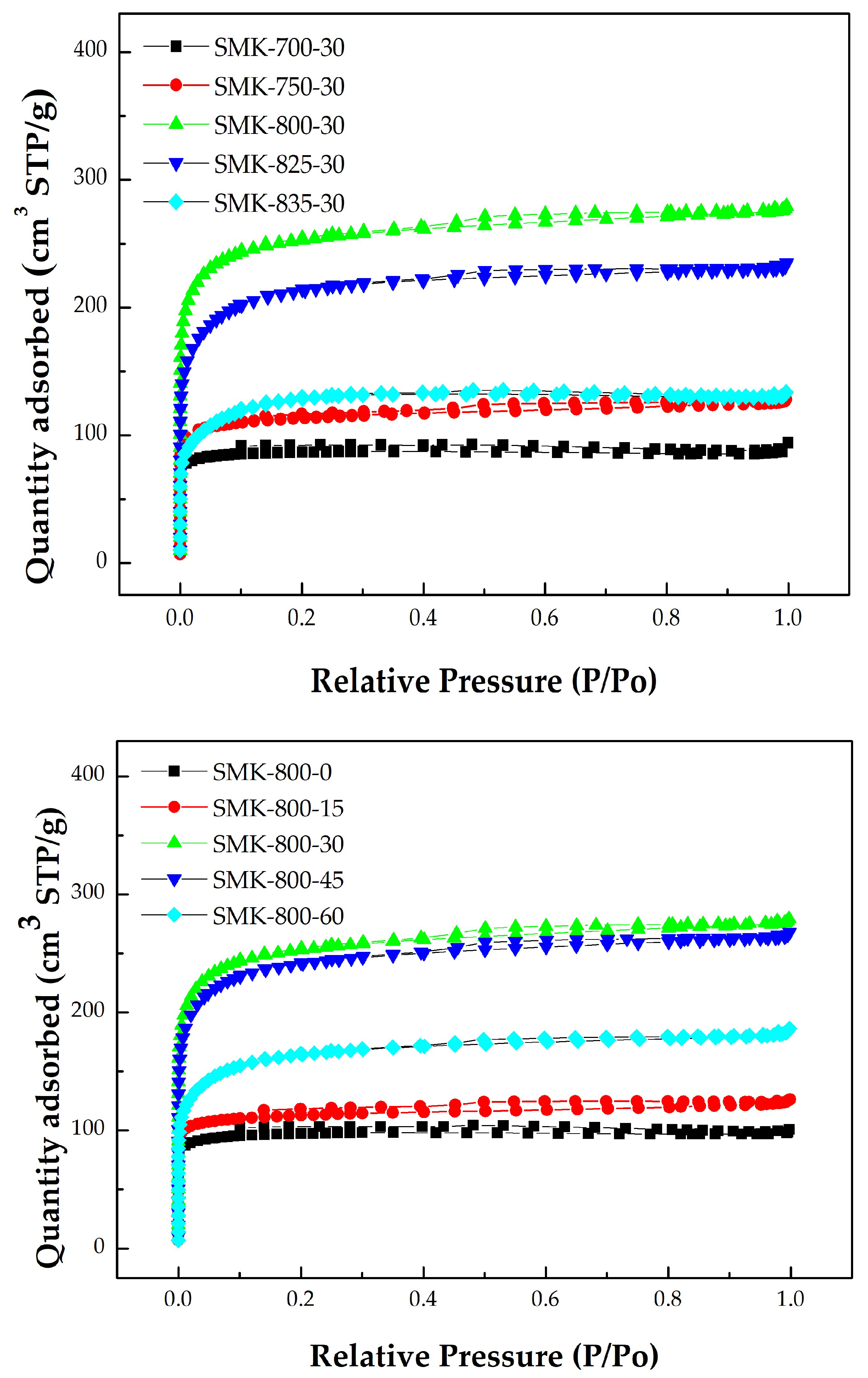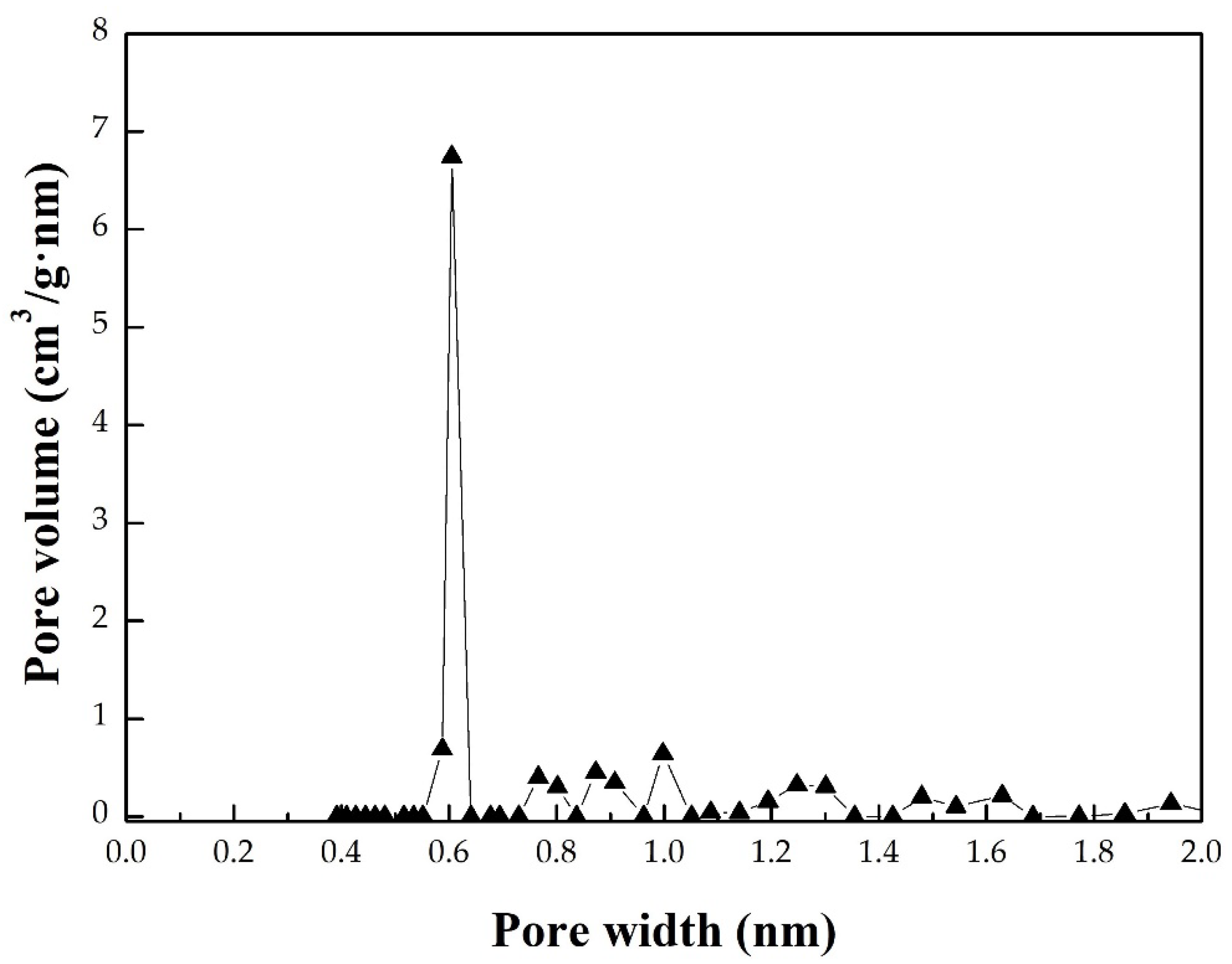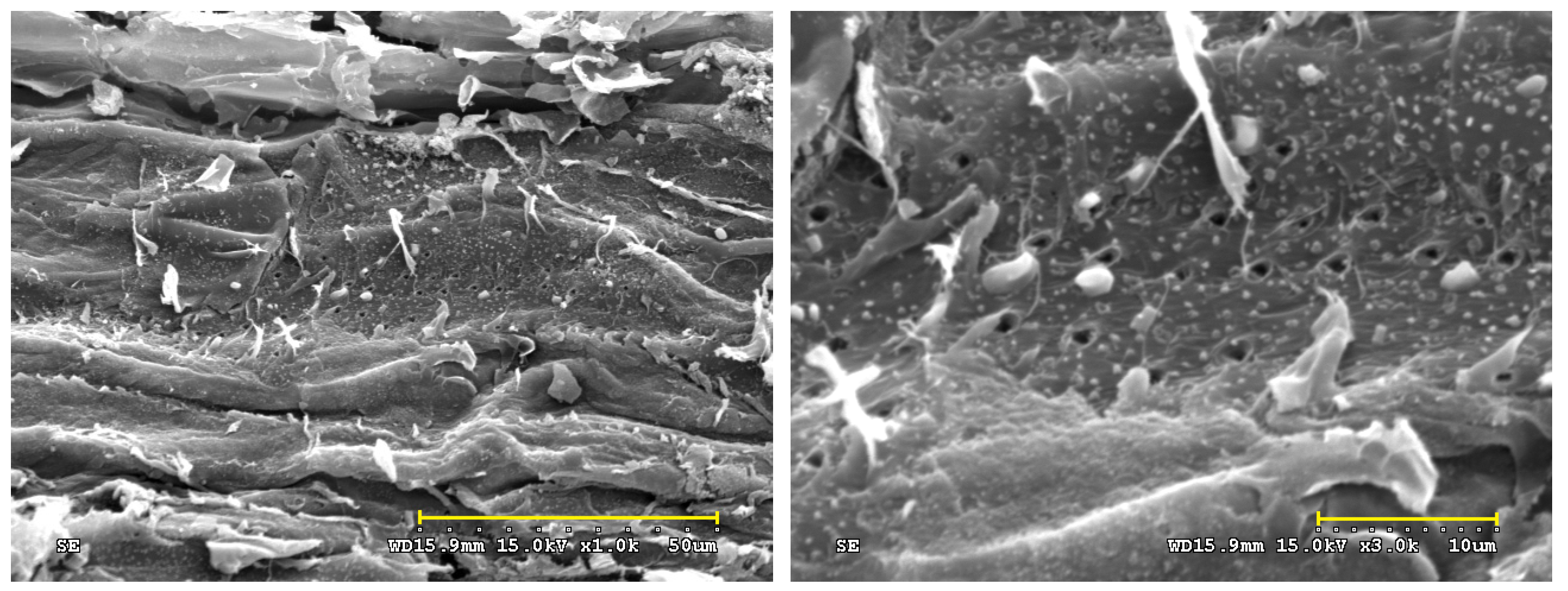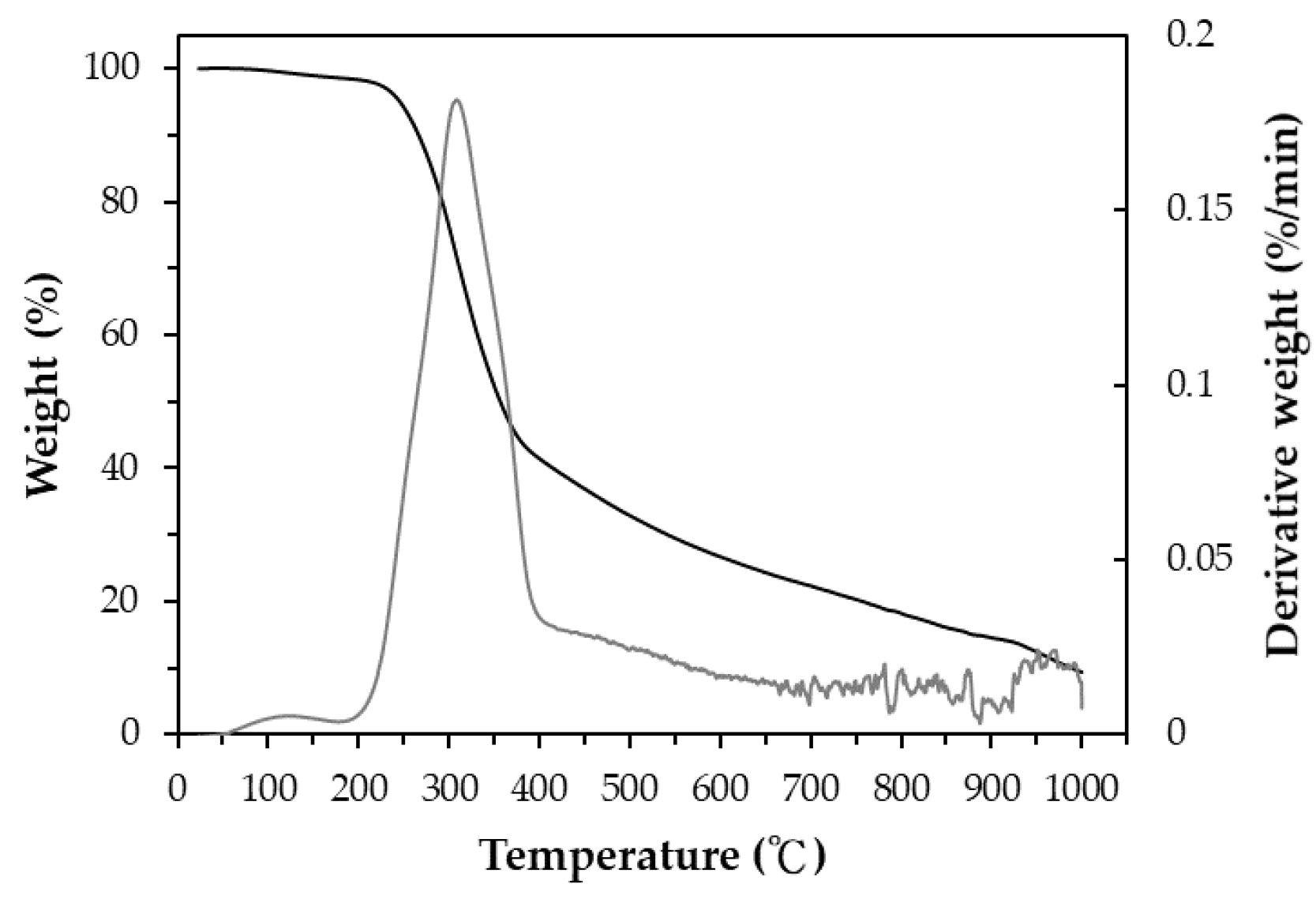Optimization of Physical Activation Process by CO2 for Activated Carbon Preparation from Honduras Mahogany Pod Husk
Abstract
:1. Introduction
2. Materials and Methods
2.1. Materials
2.2. Thermochemical Characteristics Analysis of SMK
2.3. Pyrolysis–Activation Experiments
2.4. Characterization Analysis of Resulting Activated Carbon
3. Results and Discussion
3.1. Thermochemical Properties of SMK
3.2. Texture Characteristics of Resulting Activated Carbon
- It was found that the mass yields of activated carbon produced at higher activation temperatures and larger residence times decreased continuously, causing gradual shrinkage and burn-off. Because of more CO2 gasification (activation) reactions occurring at elevated temperatures, the resulting activated carbon product was not produced or burned out at above 850 °C for a holding time of 30 min. Therefore, the lower activation temperatures at 825 °C and 835 °C were used to investigate the variations in the mass yields and texture characteristics. On the other hand, the texture characteristics of activated carbon increased as the activation temperature increased from 700 to 850 °C, giving more pore formation and the increment of the mesopore surface area (mesoporosity). Eventually, the effects of activation (or gasification) on the texture characteristics reached the optimal process conditions, where the value of the BET surface area (or total pore volume) was close to the maximum. As listed in Table 1, the main texture characteristic (the BET surface area) increased with the activation temperature increase from 700 to 800 °C for a holding time of 30 min but gradually decreased as the temperature increased thereafter from the BET surface area of 966 m2/g (SMK-800-30) to 791 m2/g (SMK-825-30) and 475 m2/g (SMK-835-30). More consistently, the total pore volume indicated a similar trend, suggesting more micropores formed at higher activation temperatures of 700 °C to 800 °C. Based on these texture characteristics, the activation temperatures ranging from 750 to 800 °C can be connected with the determining process conditions for the most surface area and pore volume gained in this work.
- Also indicated in Table 1, the residence time may be another determining process parameter in activated carbon production. The variations in the main texture characteristics were similar to those mentioned above. For example, the BET surface area increased with extending residence time from 0 min to 30 min but slightly decreased as the time extended thereafter from the maximal BET surface area (SMK-800-30) to 909 m2/g (SMK-800-45) and 609 m2/g (SMK-835-60). Therefore, the optimal activation conditions for producing SMK-based activated carbon should be fixed at 800 °C for a holding time of 30 min, having the maximal texture characteristics (i.e., BET surface area of 966 m2/g and total pore volume of 0.43 cm3/g).
- Although the mass yield of the resulting biochar (SMK-800-30-biochar) was higher than that of the resulting activated carbon (SMK-800-30), its texture characteristics were significantly lower than those of the latter. The CO2 gas played a vital role in the pore enhancement during the activation or gasification reaction (i.e., carbon and carbon dioxide reaction), causing the removal of surface oxygen complexes and more pore formation [2].
- As shown in Figure 3, the resulting activated carbon products are characteristic of microporous features, thus displaying the Type I isotherms based on the classification by the International Union of Pure and Applied Chemistry (IUPAC) [19,20,21]. In addition, the average pore width for slit pores (Wp) was close to 4.0 nm, based on the model of slit geometry. Further, there were slight hysteresis loops (Type VI isotherms) starting from approximately 0.42 of relative pressure in the desorption branch of the isotherms, which were associated with the development of mesopores. It should be noted that the pore size distributions obtained by the BJH method using the desorption branch data were not correct because the carbon materials are fundamentally microporous and do not present a considerable number of mesopores.
- By analyzing the adsorption–desorption isotherm data of a series of CO2-activated SMK, Figure 4 further depicts the micropore size distribution in the optimal activated carbon (i.e., SMK-800-30) using the 2D-NLDFT-HS model for a more accurate description of the textural characteristics [23]. The resulting activated carbon was a microporous material indeed and showed a significant micropore at 0.6 nm. In addition, these micropores should be slit-based shape as compared to the cylinder-based shape in the mesopores.
- As mentioned above, the optimal activated carbon product was the SMK-800-30, which had a BET surface area of 966 m2/g and a total pore volume of 0.43 cm3/g. In this work, scanning electron microscopy (SEM) was used to observe its porous texture on the surface using two magnifications (i.e., ×1000 and ×3000). As illustrated in the left image of Figure 5, it exhibited a smooth and rigid surface due to its carbon matrix derived from the vascular structure in the lignocellulosic biomass (i.e., SMK). When the SEM image was zoomed in at a higher magnification (i.e., ×3000, the right image of Figure 5), the activated carbon product displayed a more porous texture on its surface.



3.3. Chemical Characteristics of Resulting Activated Carbon Surface
4. Conclusions
Author Contributions
Funding
Institutional Review Board Statement
Informed Consent Statement
Data Availability Statement
Acknowledgments
Conflicts of Interest
References
- Bansal, R.C.; Donnet, J.B.; Stoeckli, F. Active Carbon; Marcel Dekker: New York, NY, USA, 1988. [Google Scholar]
- Marsh, H.; Rodriguez-Reinoso, F. Activated Carbon; Elsevier: Amsterdam, The Netherlands, 2006. [Google Scholar]
- Shaker, M.; Ghazvini, A.A.S.; Cao, W.; Riahifar, R.; Ge, Q. Biomass-derived porous carbons as supercapacitor electrodes—A review. New Carbon Mater. 2021, 36, 546–572. [Google Scholar] [CrossRef]
- Luo, L.; Lan, Y.; Zhang, Q.; Deng, J.; Luo, L.; Zeng, Q.; Gao, H.; Zhao, W. A review on biomass-derived activated carbon as electrode materials for energy storage supercapacitors. J. Energy Storage 2022, 55, 105839. [Google Scholar] [CrossRef]
- Manasa, P.; Sambasivam, S.; Ran, F. Recent progress on biomass waste derived activated carbon electrode materials for supercapacitors applications—A review. J. Energy Storage 2022, 54, 105290. [Google Scholar] [CrossRef]
- Wigmans, T. Industrial aspects of production and use of activated carbons. Carbon 1989, 27, 13–22. [Google Scholar] [CrossRef]
- Jjagwe, J.; Olupot, P.W.; Menya, E.; Kalibbala, H.M. Synthesis and application of granular activated carbon from biomass waste materials for water treatment: A review. J. Bioresour. Bioprod. 2021, 6, 292–322. [Google Scholar] [CrossRef]
- Gayathiri, M.; Pulingam, T.; Lee, K.T.; Sudesh, K. Activated carbon from biomass waste precursors: Factors affecting production and adsorption mechanism. Chemosphere 2022, 294, 133764. [Google Scholar] [CrossRef] [PubMed]
- Hoang, A.T.; Kumar, S.; Lichtfouse, E.; Cheng, C.K.; Varma, R.S.; Senthilkumar, N.; Nguyen, P.Q.P.; Nguyen, X.P. Remediation of heavy metal polluted waters using activated carbon from lignocellulosic biomass: An update of recent trends. Chemosphere 2022, 302, 134825. [Google Scholar] [CrossRef]
- Mergbi, M.; Galloni, M.G.; Aboagye, D.; Elimian, E.; Su, P.; Ikram, B.M.; Nabgan, W.; Bedia, J.; Amor, H.B.; Contreras, S.; et al. Valorization of lignocellulosic biomass into sustainable materials for adsorption and photocatalytic applications in water and air remediation. Environ. Sci. Pollut. Res. 2023, 30, 74544–74574. [Google Scholar] [CrossRef]
- Andrade, R.L.; Pico-Mendoza, J.; Morillo, E.; Buitron, J.; Meneses, S.; Navarrete, B.; Pinoargote, M.; Carrasco, B. Molecular characterization of mahogany tree (Swietenia macrophylla King, Meliaceae) in the remnant natural forest of Ecuador. Neotrop. Biodivers. 2022, 8, 222–228. [Google Scholar] [CrossRef]
- Mamun, A.A.; Mahbubul, B.M.; Khan, S.; Roy, M.N.; Hossain, M.M.; Khan, M.A. Mordant-free dyeing of nylon fabric with mahogany (Swietenia mahagoni) seed pods: A cleaner approach of synthetic fabric coloration. Textile Res. J. 2022, 92, 3111–3119. [Google Scholar] [CrossRef]
- Joardder, M.U.H.; Uddin, M.S.; Kader, M.A. Pyrolysis decomposition of mahogony seeds (Swietenia macrophylla) for alternative fuel oil. In Proceedings of the International Conference on Mechanical, Industrial and Energy Engineering, Khulna, Bangladesh, 23–24 December 2010. [Google Scholar]
- Tsai, W.T.; Huang, P.C. Characterization of acid-leaching cocoa pod husk (CPH) and its resulting activated carbon. Biomass Convers. Biorefin. 2018, 8, 521–528. [Google Scholar] [CrossRef]
- Tsai, W.T.; Jiang, T.J. Mesoporous activated carbon produced from coconut shell using a single-step physical activation process. Biomass Convers. Biorefin. 2018, 8, 711–718. [Google Scholar] [CrossRef]
- Tsai, W.T.; Jiang, T.J.; Lin, Y.Q. Conversion of de-ashed cocoa pod husk into high-surface-area microporous carbon materials by CO2 physical activation. J. Mater. Cycles Waste Manag. 2019, 21, 308–314. [Google Scholar] [CrossRef]
- Lin, Y.Q.; Tsai, W.T. Liquid-phase removal of methylene blue as organic pollutant by mesoporous activated carbon prepared from water caltrop husk using carbon dioxide activation. Processes 2021, 9, 144. [Google Scholar] [CrossRef]
- Tsai, W.T.; Jiang, T.J. Optimization of physical activation process for activated carbon preparation from water caltrop husk. Biomass Convers. Biorefin. 2023, 13, 6875–6884. [Google Scholar] [CrossRef]
- Gregg, S.J.; Sing, K.S.W. Adsorption, Surface Area, and Porosity; Academic Press: London, UK, 1982. [Google Scholar]
- Condon, J.B. Surface Area and Porosity Determinations by Physisorption: Measurements and Theory; Elsevier: Amsterdam, The Netherlands, 2006. [Google Scholar]
- Lowell, S.; Shields, J.E.; Thomas, M.A.; Thommes, M. Characterization of Porous Solids and Powders: Surface Area, Pore Size and Density; Springer: Dordrecht, The Netherlands, 2006. [Google Scholar]
- Rouquerol, J.; Llewellyn, P.; Rouquerol, F. Is the BET equation applicable to microporous adsorbents? In Studies in Surface Science and Catalysis; Elsevier: Amsterdam, The Netherlands, 2007; pp. 49–56. [Google Scholar]
- Jagiello, J.; Castro-Gutierrez, J.; Canevesi, R.L.S.; Celzard, A.; Fierro, V. Comprehensive analysis of hierarchical porous carbons using a dual-shape 2D-NLDFT model with an adjustable slit-cylinder pore shape Boundary. ACS Appl. Mater. Interfaces 2021, 13, 49472–49481. [Google Scholar] [CrossRef]
- Joseph, S.D.; Munroe, P.R. Application of scanning electron microscopy to the analysis of biochar-related materials. In Biochar: A Guide to Analytical Methods; Singh, B., Camps-Arbestain, M., Lehmann, J., Eds.; CRC Press: Boca Raton, FL, USA, 2017; pp. 272–282. [Google Scholar]
- Jenkins, B.M.; Baxter, L.L.; Miles, T.R., Jr.; Miles, T.R. Combustion properties of biomass. Fuel Process Technol. 1998, 54, 17–46. [Google Scholar] [CrossRef]
- Vassilev, S.V.; Baxter, D.; Andersen, L.K.; Vassileva, C.G. An overview of the chemical composition of biomass. Fuel 2010, 89, 913–933. [Google Scholar] [CrossRef]
- Lachman, J.; Balas, M.; Lisy, M.; Lisa, H.; Milcak, P.; Elbl, P. An overview of slagging and fouling indicators and their applicability to biomass fuels. Fuel Process Technol. 2021, 217, 106804. [Google Scholar] [CrossRef]
- Basu, P. Biomass Gasification, Pyrolysis and Torrefaction, 2nd ed.; Academic Press: London, UK, 2013. [Google Scholar]
- Yang, H.; Yan, R.; Chen, H.; Lee, D.H.; Zheng, C. Characteristics of hemicellulose, cellulose and lignin pyrolysis. Fuel 2007, 86, 1781–1788. [Google Scholar] [CrossRef]
- Díez, D.; Urueña, A.; Piñero, R.; Barrio, A.; Tamminen, T. Determination of hemicellulose, cellulose, and lignin content in different types of biomasses by thermogravimetric analysis and pseudocomponent kinetic model (TGA-PKM method). Processes 2020, 8, 1048. [Google Scholar] [CrossRef]
- Li, L.; Yao, X.; Li, H.; Liu, Z.; Ma, W.; Liang, X. Thermal stability of oxygen-containing functional groups on activated carbon surfaces in a thermal oxidative environment. J. Chem. Eng. Jpn. 2004, 47, 21–27. [Google Scholar] [CrossRef]
- Islam, M.S.; Ang, B.C.; Gharehkhani, S.; Afifi, A.B.M. Adsorption capability of activated carbon synthesized from coconut shell. Carbon. Lett. 2016, 20, 1–9. [Google Scholar] [CrossRef]
- Johnston, C.T. Biochar analysis by Fourier-transform infra-red spectroscopy. In Biochar: A Guide to Analytical Methods; Singh, B., Camps-Arbestain, M., Lehmann, J., Eds.; CRC Press: Boca Raton, FL, USA, 2017; pp. 199–228. [Google Scholar]
- Qiu, C.; Jiang, L.; Gao, Y.; Sheng, L. Effects of oxygen-containing functional groups on carbon materials in supercapacitors: A review. Mater. Des. 2023, 230, 111952. [Google Scholar] [CrossRef]




| Activated Carbon a | Yield (wt%) | SBET b (m2/g) | Smicro c (m2/g) | Vt d (cm3/g) | Vmicro c (cm3/g) | Wp e (nm) |
|---|---|---|---|---|---|---|
| SMK-800-30-Biochar f SMK-700-30 | 22.51 26.76 | 216 h 311 h | 159 241 | 0.10 0.14 | 0.08 0.12 | 4.22 4.18 |
| SMK-750-30 | 23.87 | 405 h | 277 | 0.20 | 0.14 | 4.52 |
| SMK-800-30 | 13.39 | 966 | 600 | 0.43 | 0.30 | 4.30 |
| SMK-825-30 g | 6.01 | 791 | 452 | 0.36 | 0.23 | 4.24 |
| SMK-835-30 | 3.83 | 475 | 235 | 0.21 | 0.12 | 3.96 |
| SMK-800-00 | 24.43 | 350 h | 267 | 0.15 | 0.13 | 4.00 |
| SMK-800-15 | 19.89 | 402 h | 288 | 0.19 | 0.15 | 4.50 |
| SMK-800-30 g | 13.39 | 966 | 600 | 0.43 | 0.30 | 4.30 |
| SMK-800-45 | 7.90 | 909 | 547 | 0.41 | 0.28 | 4.32 |
| SMK-800-60 | 5.41 | 609 | 328 | 0.29 | 0.17 | 4.46 |
Disclaimer/Publisher’s Note: The statements, opinions and data contained in all publications are solely those of the individual author(s) and contributor(s) and not of MDPI and/or the editor(s). MDPI and/or the editor(s) disclaim responsibility for any injury to people or property resulting from any ideas, methods, instructions or products referred to in the content. |
© 2023 by the authors. Licensee MDPI, Basel, Switzerland. This article is an open access article distributed under the terms and conditions of the Creative Commons Attribution (CC BY) license (https://creativecommons.org/licenses/by/4.0/).
Share and Cite
Tsai, C.-H.; Tsai, W.-T. Optimization of Physical Activation Process by CO2 for Activated Carbon Preparation from Honduras Mahogany Pod Husk. Materials 2023, 16, 6558. https://doi.org/10.3390/ma16196558
Tsai C-H, Tsai W-T. Optimization of Physical Activation Process by CO2 for Activated Carbon Preparation from Honduras Mahogany Pod Husk. Materials. 2023; 16(19):6558. https://doi.org/10.3390/ma16196558
Chicago/Turabian StyleTsai, Chi-Hung, and Wen-Tien Tsai. 2023. "Optimization of Physical Activation Process by CO2 for Activated Carbon Preparation from Honduras Mahogany Pod Husk" Materials 16, no. 19: 6558. https://doi.org/10.3390/ma16196558
APA StyleTsai, C.-H., & Tsai, W.-T. (2023). Optimization of Physical Activation Process by CO2 for Activated Carbon Preparation from Honduras Mahogany Pod Husk. Materials, 16(19), 6558. https://doi.org/10.3390/ma16196558







